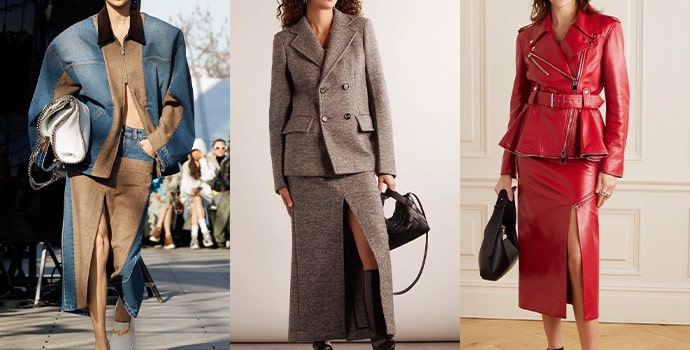The Best Fabrics to Look for in Branded Clothing for Summer
Recognizing Clothing: The Importance of Fabric Options in Your Closet
The option of fabric in clothes plays a crucial role in both appearances and performance. Various products supply varying levels of breathability, durability, and convenience, directly affecting the user's experience. Understanding these nuances can improve one's wardrobe significantly. Several ignore just how these selections can affect not just personal design, however likewise sustainability. What fabric decisions could redefine your wardrobe and straighten it with both design and duty?
The Function of Fabric in vogue and Performance

Typical Fabric Types and Their Features
When picking clothes, comprehending the features of typical fabric types is crucial for making notified choices. Cotton, a widely-used all-natural fiber, is understood for its gentleness, convenience, and breathability, making it suitable for laid-back wear and everyday garments. Linen, one more all-natural alternative, flaunts exceptional moisture-wicking homes and an unique appearance, suitable for cozy climates.Wool, often favored for its warmth and longevity, differs in excellence; merino wool is soft against the skin, while coarser types are used for outerwear. Synthetic textiles like polyester and nylon offer toughness and resistance to creases, making them preferred for activewear and traveling garments. Lastly, blends, which incorporate artificial and natural fibers, can improve performance while keeping convenience. By acknowledging these fabric attributes, individuals can pick clothes that aligns with their way of life and aesthetic choices.
Breathability and Convenience: Selecting the Right Fabrics for Various Climates
Selecting the ideal fabrics for various environments can substantially enhance comfort and overall wearability. Breathable materials are necessary in hot environments, as they allow air blood circulation and moisture dissipation. Fabrics such as cotton, bed linen, and moisture-wicking synthetics properly draw sweat far from the body, keeping the user cool and dry. Conversely, in chillier climates, thicker materials like wool or fleece provide insulation while keeping breathability, guaranteeing warmth without overheating.Additionally, the selection of material weight plays a vital duty; lightweight fabrics are more effective for summertime, whereas much heavier alternatives are fit for winter wear. Recognizing the distinct properties of each textile allows people to clothe appropriately for differing climate condition. Inevitably, selecting breathable and comfy materials tailored to certain climates can greatly boost day-to-day comfort and enhance the total experience of using apparel.
Longevity and Treatment: Just How Fabric Affects Long Life of Your Closet
Choosing the appropriate products can considerably affect the toughness and treatment needs of a closet. Fabrics such as cotton and polyester are known for their resilience and convenience of maintenance, making them ideal for daily wear. In contrast, delicate materials like silk and shoelace call for more mindful handling and specialized cleansing methods, which can increase the moment and effort needed for care. Branded Clothing.Durability is also affected by the textile's weave and surface; firmly woven textiles tend to resist deterioration far better than loosely woven options. In addition, synthetic blends usually provide improved longevity, incorporating the finest qualities of several fibers.Understanding the treatment directions for each and every textile is necessary, as webpage improper cleaning or drying out can lead to premature wear. Eventually, picking durable products can bring about a longer-lasting closet, minimizing the regularity of replacements and adding to a more sustainable style option
The Influence of Fabric on Fit and Silhouette

Lasting Material Options: Making Eco-Friendly Decisions
The influence of fabric expands past fit find out here and silhouette to incorporate environmental aspects, motivating a growing interest in sustainable textile choices. Eco-friendly fabrics, such as natural cotton, hemp, and Tencel, are getting grip amongst consumers who focus on sustainability in their wardrobes. These products are typically produced with fewer chemicals and water, reducing their environmental footprint.Additionally, recycled fabrics, made from post-consumer waste, supply an ingenious option to the textile sector's pollution issue. Brands significantly welcome openness in their sourcing techniques, allowing customers to make educated decisions concerning their purchases.Choosing sustainable materials not only supports moral techniques but also urges the garment industry to embrace even more responsible manufacturing methods. As recognition of ecological concerns climbs, individuals are urged to review the lasting effect of their material options, cultivating an activity towards an extra sustainable and ecologically conscious method to fashion.
Elevating Design: Exactly How Fabric Can Change a Clothing
While numerous may concentrate on color and cut when selecting an attire, the choice of textile plays a necessary role in boosting style and boosting general look. Various products communicate unique moods and messages; as an example, silk emanates deluxe and class, while jeans uses a casual, unwinded vibe. The appearance and drape of a textile can dramatically alter the silhouette, with organized fabrics providing a polished look and softer ones developing a more fluid, kicked back aesthetic.Moreover, the weight of the fabric affects wearability throughout seasons. Lightweight textiles like linen and cotton are perfect for summer season, while larger materials such as woollen and velour provide warmth and elegance in chillier months. Recognizing textile residential properties, such as breathability and stretch, additionally equips individuals to make educated options that improve convenience without endangering style. Eventually, the right fabric can change a clothing from normal to extraordinary, making it an essential consideration in any kind of closet.
Frequently Asked Inquiries
Just how Do I Identify the Textile Content of My Clothing?
To determine fabric material, one can check out treatment labels, conduct melt examinations for fiber recognition, or get in touch with fabric swatches. These techniques help differentiate materials, making sure informed selections for garments treatment and maintenance in everyday wear.
Can Material Selection Affect My State Of Mind or Confidence?
Textile option can considerably affect a person's mood and self-confidence. Branded Clothing. Certain products might stimulate sensations of comfort or sophistication, while others can really feel uncomplimentary or limiting, inevitably affecting self-perception and emotional health throughout the day
What Fabrics Are Finest for Delicate Skin?
For individuals with sensitive skin, natural materials like bamboo, cotton, and linen are typically recommended. These materials are breathable, hypoallergenic, and much less most likely to create irritability, making them ideal options for comfort and skin health.
Just how Do I Appropriately Clean and Look After Various Fabrics?
To properly care and clean for different fabrics, one should consider each product's particular demands, including temperature level settings, cleaning agents, and drying out methods, ensuring durability and preserving the material's initial high qualities for perfect use.
Exist Details Fabrics for Athletic or Efficiency Wear?
Athletic or performance wear often uses materials such as nylon, spandex, and polyester. These products are designed for moisture-wicking, breathability, and adaptability, enhancing activity and convenience throughout exercises while giving durability and assistance. Alternatively, in colder environments, thicker materials like wool or fleece offer insulation while keeping breathability, making sure heat without overheating.Additionally, the selection of material weight plays an essential duty; light-weight fabrics are more suitable for summer season, whereas much heavier choices are fit for winter months wear. In comparison, delicate materials like silk and shoelace require even more careful handling and specialized cleaning methods, which can increase the time and effort needed for care.Durability is additionally influenced by the material's weave and coating; securely woven textiles have a tendency to resist wear and tear much better than freely woven alternatives. In contrast, rigid materials can restrict additional resources movement however offer a traditional, refined look.Moreover, the density and texture of the textile can influence the visual perception of body shape. The impact of textile extends past fit and silhouette to encompass environmental factors, prompting a growing passion in sustainable material options. The appearance and drape of a textile can substantially modify the silhouette, with structured materials providing a polished look and softer ones creating a more fluid, kicked back aesthetic.Moreover, the weight of the material affects wearability across seasons.